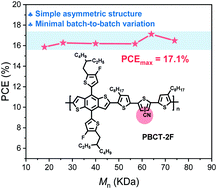A donor polymer based on 3-cyanothiophene with superior batch-to-batch reproducibility for high-efficiency organic solar cells†
Abstract
The realization of high-efficiency organic solar cells (OSCs) relies largely on donor polymers. However, high-performance donor polymers are limited to a handful of building blocks, which usually suffer from lengthy synthesis and high production cost. Moreover, most donor polymers exhibited strong batch-to-batch variation. Herein, we report a new building block, 3-cyanothiophene (CT), which features a very simple asymmetric structure and facile synthesis. The donor polymer (PBCT-2F) based on the CT unit realized a remarkable power conversion efficiency (PCE) of 17.1%. More importantly, PBCT-2F exhibited excellent batch-to-batch reproducibility. The six polymer batches with molecular weights ranging from 18 to 74 kDa produced very similar PCEs: 15.9–17.1% and 12.7–13.2% when the polymer was blended with Y6 and IT-4F, respectively. These results suggest the great potential of PBCT-2F for industrial synthesis and large-scale manufacturing of OSC modules. This work also demonstrates the bright future of CT units for constructing high-performance donor polymers.



 Please wait while we load your content...
Please wait while we load your content...